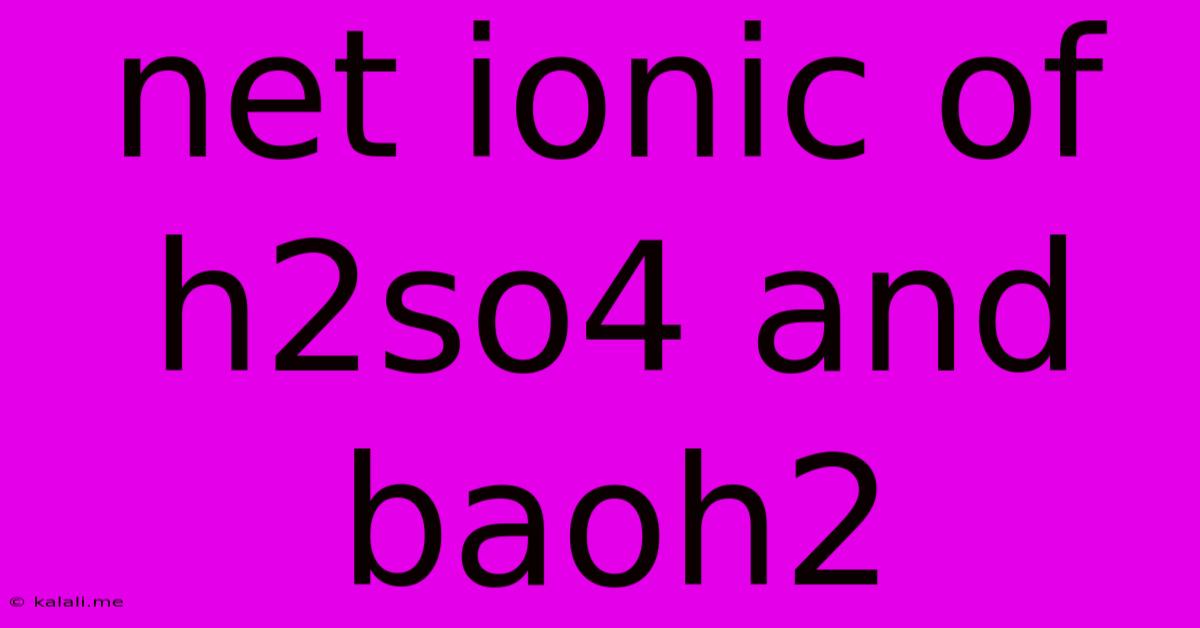Net Ionic Of H2so4 And Baoh2
Kalali
Jun 03, 2025 · 3 min read

Table of Contents
The Net Ionic Equation for the Reaction Between H₂SO₄ and Ba(OH)₂
This article will explore the complete ionic and net ionic equations for the reaction between sulfuric acid (H₂SO₄) and barium hydroxide (Ba(OH)₂). Understanding these equations is crucial for grasping the fundamental principles of acid-base chemistry and stoichiometry. This reaction is a classic example of a strong acid-strong base neutralization, resulting in the formation of a salt and water.
The reaction between sulfuric acid and barium hydroxide is a double displacement reaction, also known as a neutralization reaction. The reactants are a strong acid and a strong base, meaning they fully dissociate in aqueous solutions. This complete dissociation is key to writing the complete and net ionic equations.
Writing the Balanced Molecular Equation
First, let's write the balanced molecular equation for the reaction:
H₂SO₄(aq) + Ba(OH)₂(aq) → BaSO₄(s) + 2H₂O(l)
This equation shows that sulfuric acid reacts with barium hydroxide to produce barium sulfate and water. Notice that barium sulfate (BaSO₄) is a precipitate, indicated by the (s) state symbol. This is a key observation for determining the net ionic equation.
Determining the Complete Ionic Equation
To write the complete ionic equation, we need to break down all the aqueous compounds into their respective ions:
2H⁺(aq) + SO₄²⁻(aq) + Ba²⁺(aq) + 2OH⁻(aq) → BaSO₄(s) + 2H₂O(l)
This equation shows all the ions present in the solution before the reaction takes place. Note that barium sulfate and water remain as molecules because they are not soluble ionic compounds and a covalent compound, respectively.
Deriving the Net Ionic Equation
The net ionic equation shows only the species that are directly involved in the reaction. To obtain this, we eliminate the spectator ions – ions that appear on both sides of the complete ionic equation unchanged. In this case, there are no spectator ions. Therefore, the net ionic equation is the same as the complete ionic equation:
2H⁺(aq) + SO₄²⁻(aq) + Ba²⁺(aq) + 2OH⁻(aq) → BaSO₄(s) + 2H₂O(l)
While seemingly the same, it is crucial to understand that the net ionic equation represents only the essential changes happening at the atomic level during the reaction. The spectator ions, though present, do not participate directly in the formation of the precipitate or water.
Understanding the Significance
This reaction highlights several important concepts:
- Neutralization: The reaction of a strong acid and a strong base neutralizes each other, resulting in a neutral pH (or close to it) if the reactants are in stoichiometric amounts.
- Precipitation: The formation of a solid precipitate (barium sulfate in this case) is a common driving force for double displacement reactions. Barium sulfate's insolubility is key to this reaction proceeding.
- Ionic Equations: Complete and net ionic equations provide a more detailed view of the reaction at the ionic level, highlighting the actual species involved in the chemical change.
By understanding these equations and the underlying chemistry, you can better predict the products of similar reactions and comprehend the stoichiometry involved in acid-base neutralizations. Remember that correctly identifying the states of matter (aqueous, solid, liquid, gas) is crucial for writing accurate complete and net ionic equations.
Latest Posts
Latest Posts
-
How Many Cups Of Powdered Sugar In One Box
Jun 04, 2025
-
Sql Bypass Error When Inserting A Row
Jun 04, 2025
-
Can You Actually Buy The Bike In Pokemon
Jun 04, 2025
-
How To Address A Former President In Writing
Jun 04, 2025
-
Why Does My Cat Hate Being Held
Jun 04, 2025
Related Post
Thank you for visiting our website which covers about Net Ionic Of H2so4 And Baoh2 . We hope the information provided has been useful to you. Feel free to contact us if you have any questions or need further assistance. See you next time and don't miss to bookmark.